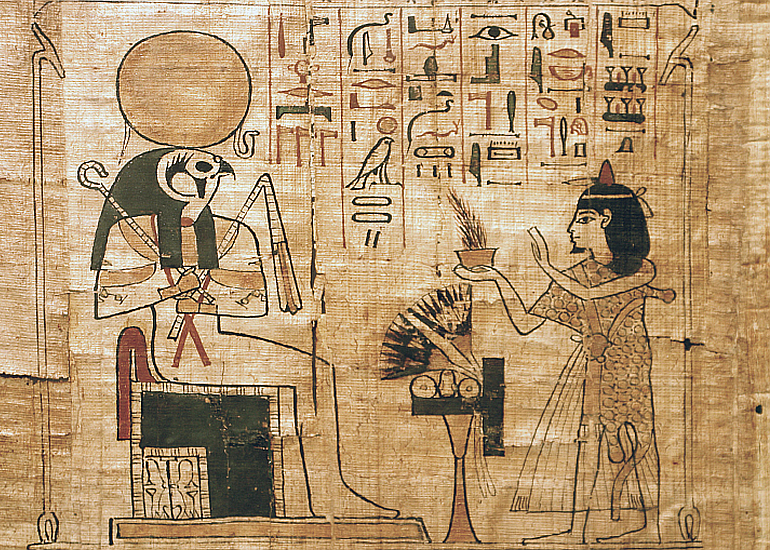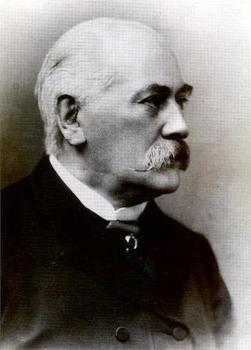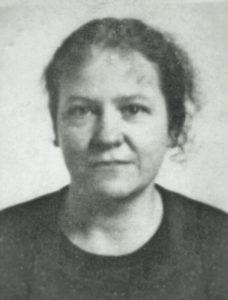Ancient Egyptian Papyri in the National Library of Russia
History of Description
The first to appear in the scientific literature were the Denon Papyri which were studied by J.-F. Champollion from an engraved edition. Since the Denon Scrolls as well as the Norov Papyrus were not deciphered, they were not included in the Union Catalogue of Oriental Manuscripts, published under the editorship of academician Boris Andreevich Dorn who only mentioned them in the preface. Apparently, the Norov Papyrus eventually dropped out of sight of the the curators of the collection. At a time when the task of describing the Egyptian scrolls arose, the Bagration Papyrus, acquired later, was described next to the Denon Papyri instead of it. This happened in 1862, when, at the request of the Library Directorate, the German Egyptologist Heinrich Karl Brugsch (1827-1894) compiled a Catalogue of Egyptian Manuscripts, including Coptic and three hieratic papyri. Photocopies of papyri are pasted into this handwritten catalogue compiled in Berlin, and this suggests that their originals, unlike the Coptic manuscripts, were not taken out of St. Petersburg. That is probably why Brugsch could not pay attention to a note on the reverse side of one of the scrolls. (At the end of November 1862, on the initiative of B. A. Dorn, the library obtained for a German scientist a diamond ring as a gift from the Emperor.)
Brugsch did not identify the Denon Papyri. Neither did the Norwegian Egyptologist Jens Daniel Carolus Lieblein (1837–1911), who gave brief descriptions of all four scrolls in his book Ancient Egyptian Monuments in St. Petersburg, Helsingfors, Uppsala and Copenhagen, published in 1873. Only Gaston Camille Charles Maspero (1846–1916), who founded the French Institute of Oriental Archeology in Cairo in 1880, refers to the Denon Papyri in his article about the royal mummies discovered during excavations in Deir el-Bahari and mentions in a footnote, “These two papyri were acquired by Russia and are now in the Imperial Library of St. Petersburg, where Lieblein found them". Both Lieblaine and Maspero associated the Petersburg scrolls with the name of Osorkon III, Pharaoh of the 23d Dynasty, who ruled approximately in 795–67 BC.
That Osorkon I of the 22nd Dynasty is meant there was established by Vera Evgenova (1898–1953), who compiled an inventory of the holdings of papari and related material in 1951. At the same time, she prepared an article about them, published in 1957, after her death. When describing the papyri, we used the information from this article.
Later, her view was supported by the German Egyptologist Karl Jansen-Winkeln who included several texts from the collections of St. Petersburg, Moscow, Odessa and Kazan in his book.
In 1998, Oleg Berlev and Svetlana Khodzhash published the Catalogue of the Monuments of Ancient Egypt. From the Museums of the Russian Federation, Ukraine, Bielorussia, the Caucasus, Central Asia and the Baltic States, in which they gave detailed descriptions of the Library's papyri and provided the most complete bibliography to that date.
In 2012, the Moscow Egyptologist Viktor Solkin published an article on four papyri, in which he gave his own interpretation of their contents, as well as new translations of the title, which in the Russian version sound like this: “What is in the Underworld” or “The Book of the Hidden Chamber". The same data, but only about the Denon Papyri, are repeated in the preface by V. V. Solkin to a translation of Denon's book Travels to Lower and Upper Egypt during the Campaigns of General Bonaparte into Russian.
The album-appendix to this book, published by Natalia Malykhina, also contained reproductions of the engravings by Jean Duplessis-Bertaux after Denon's drawings of the papyri that belonged to him.
In 2021, Novosibirsk Egyptologist Maxim Panov published hieroglyphic and Latin transcriptions of the hieratic text and a translation of the first Denon papyrus into Russian.
Images of two papyri were featured in the commemorative albums The National Library of Russia: 1795-1995 (1995) and The National Library of Russia: On the 200th Anniversary of the Opening (2014).
The history of the acquisition of three papyri is described in the monograph Written Monuments of the East in the National Library of Russia: The History of the Collection’s Development: 1795-1850 by O. V. Vasilyeva.
The first Denon Papyrus was included in the "For Lovers of National Learning and Enlightenment. Hermitage and Public Libraries. 1762-1862" exhibition catalogue (2022) of the State Hermitage Museum.
As for the restoration work, they were undertaken in the second half of the 1930s. In doing so, the scrolls of A. S. Norov and P. P. Bagration were framed with glass, by analogy with the Denon Papyri. Visible evidence of the restoration is the portrait of Nikolai Tikhonov (1882–1942), a well-known specialist in archaeological and photographic technologies, the initiator and first Director of the Laboratory for the Conservation and Restoration of Documents, established in 1934 as part of the Department of Social Sciences of the USSR Academy of Sciences. The portrait depicts Tikhonov holding one of the Denon Papyri, taken out of the glass of a historical wooden frame.



